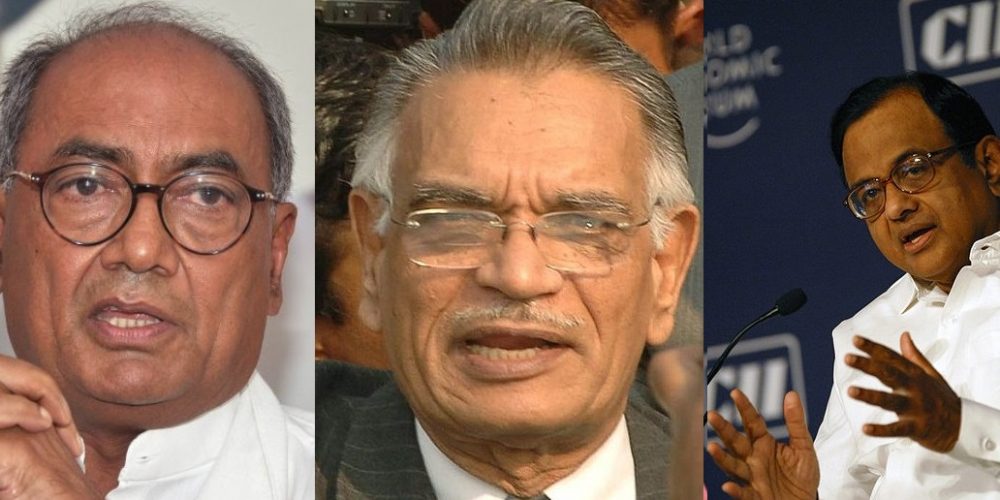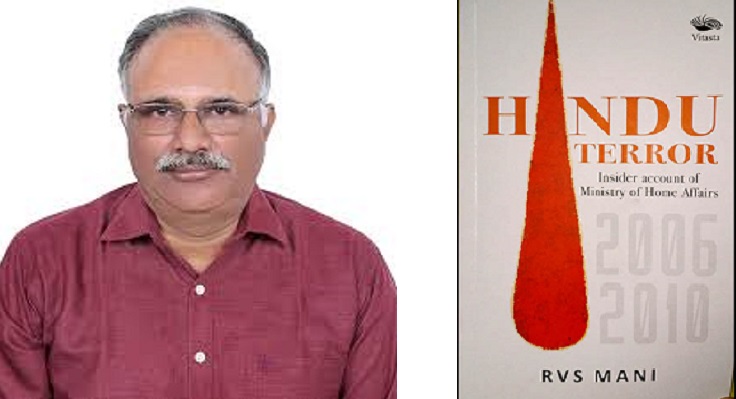In 2008, a new term suddenly appeared in Indian newspapers, which made little sense to most people of India – Saffron (or Hindu) terror. In August 2010, then Home Minister P. Chidambaram, while speaking at a conference of police chiefs, security and intelligence officials said that Hindu terrorists were behind many of the recent bomb blasts. A month earlier, according to a Wikileaks cable, Rahul Gandhi had told US Ambassador Timothy Roemer that radicalized Hindus were a bigger threat to India than Lashkar-e-Taiba.”
A new book “Hindu Terror – Insider Account of Ministry of Home Affairs” by RVS Mani reveals the scurrilous machinations by which a United Progressive Alliance (UPA) government ensured that a fake narrative of Hindu terror was brought into public discourse while evidence relating to real terrorists was suppressed. This whistleblower account by a former Home Ministry officer presents a shocking picture of a nation whose security was seriously compromised at the highest levels resulting in a series of terror attacks including the 26/11 Mumbai attack.
The author starts his narrative from the period when he was appointed Under Secretary at the Internal Security Division, Ministry of Home Affairs (MHA). He describes the core work of the department as consisting of providing answers and documentation for questions, motions, and calling-attention notices of both Houses of Parliament. He meticulously recounts the various terror attacks during the period 2005-2006 – the Varanasi bomb blasts, the IISc Bengaluru bomb blast, Delhi blasts, and the RSS Headquarters blast, in all of which, the apprehended persons were Muslims.
The author recounts how he was summoned to the office of the Home Minister in 2006 to furnish details of investigations at which point he realized that his political bosses were not happy with the information that “a particular religious group was involved in most of the terror attacks.” This moment is easily one of the high points of the book. The author describes how Shivraj Patil, then Home Minister, watched indifferently while two people Digvijaya Singh and Hemant Karkare, both whom the author met for the first time, questioned him regarding the source of his inputs. Clearly, they were not satisfied with the religion of the terrorists. A few days later a “Hindu Terror” case came on the records for the first time. A small-time businessman in Nanded who set fire to his workshop in order to make a false insurance claim was accused of storing explosives in his workshop and his connection with Bajrang Dal was used to manufacture a new brand of terrorism.
The book outlines how a similar procedure was followed with regard to investigating the blasts in Malegaon. Preliminary enquiries by the local police pointed to “an extremely orthodox Islamic group known as Ahl-e-Hadith (known in India as the Ahl-e-Hadees),” however, as soon as Karkare took charge of the case, the narrative was changed to incorporate Hindu organizations as prime suspects. The author explains how it typically took five to six months to identify perpetrators of various terror attacks. This included the time to complete rigorous procedures, obtain clearances and various other activities in order to ensure that the right persons were arrested. But, in the Malegaon case it took just 35 days for Karkare to determine that Malegaon was the “handiwork of Hindu terror groups, although the field level police personnel of the range continued to report that Ahl-e-Hadith/Hadees was involved”. A similar approach was taken to various other cases including the Samjhauta Express blast, Ajmer Sharif blast and Batla House encounter.
It becomes clear that the Mumbai attack of 26/11 was just waiting to happen. As the author says poignantly:
“At a time when we had the best team in the IS division of the MHA, the attitude of the government in power and intent to colour every terror incident as “saffron” and their ambivalence in acting against the real perpetrators of the terror attacks was making this country a cannon fodder for those with evil designs against India.”
Throughout the book, the author does not hesitate to name persons fearlessly, whether they are ministers or bureaucrats. He gives many references for readers to make further checks.
After the Mumbai terror attack, a new Home Minister P Chidambaram was appointed who ostensibly established more stringent measures to counter terror. Two new security bills were passed and the National Investigation Agency (NIA) was set up. But, as the author reveals: “it was amply clear that under the garb of new initiatives, the new Home Minister had pulled wool over the nation’s eyes.” All procedures were violated as the Minister went on to appoint his own man as the Director-General of NIA who in turn built his team with men handpicked from Kerala or Kashmir. The author recounts that the sole aim of NIA throughout 2009-2010 was to strengthen the non-existent Hindu terror concept by any means possible. The “first set of evidences” were being “overlooked” and replaced with evidences supporting the “Hindu terror narrative”, and yet no one – not even those who wanted to – could stop this farce. As the author explains, it was a Hobson’s choice for bureaucrats – your career was doomed if you stood for the truth and your nation was doomed if you kept quiet. Meanwhile, Chidambaram went on to speak about saffron terror even at a gathering of Islamic clerics and scholars in Deoband.
A sad picture of complicity emerges between Pakistani government and terrorist sympathizers within the highest echelons of the Indian government. The author reveals how intelligence inputs about a possible coastal attack were ignored due to interventions by someone from the topmost political office. Also, despite the overwhelming evidence of Pakistan’s involvement in the Mumbai terror, there were attempts to play down the role of Pakistan even from the Indian side. A failed effort to kidnap the author led him to clues about a plan to trade an officer of the MHA for Ajmal Kasab so that the terrorist would not be interrogated and his Pakistani citizenship would not be established.
Another interesting aspect that is disclosed in the book is that unlike what is portrayed in public discourse, the US gave direct access to NIA to question terrorist David Headley (Daood Sayed Gilani). Headley cooperated with both the US and the Indian authorities. The MHA led by Chidambaram received the entire report of the investigating team, however his office “excised portions of the Headley testimony to NIA” before submitting them to courts. The author accuses the UPA-led Indian government of peddling a public lie that the US had been obstructing access to Headley.
One point made strongly is that India’s intelligence and security establishments are outstanding in their professionalism and performance. Almost every terror attack has been preceded by intelligence inputs, which have often not been acted upon, and sometimes deliberately. These inputs have saved the country from innumerable attacks, which are not known to the public. The author reflects that while “the top brass intervening in the regular security procedures would never be exposed before the public, the intelligence and security establishments would be blamed for abject failure although they had done their professional work in an exemplary and outstanding manner.” He points out that this branding as a failure has angered the entire security establishment.
Perhaps, the only criticism this reviewer has for the book is the misleading nature of the title. Since the entire chronicle is about creating a false narrative of Hindu involvement in terror attacks, it would have been appropriate to refer to fake Hindu terror in the title.
Still, there is no denying that this is one of the most important books to be published in recent times. It is written by a man who was privy to the happenings inside government offices during the worst ever terror attack faced by India. He has personally paid a heavy price for deposing in the Ishrat Jahan case. Enormous pressure was put on him to testify that there was no encounter in the case and that an “innocent” Muslim girl was framed as a terrorist involved in a plot to assassinate then Chief Minister of Gujarat, Narendra Modi..
The book fills one with worry and trepidation about the vulnerabilities of the world’s largest democracy. It raises questions about Hinduphobia, about appeasement of Muslims and the peddling of false narratives. It is also a call to action – to identify and neutralize the Breaking India forces, whether in government or academia or journalism or religious bodies or any other institution. How can blatant prejudice or political calculations be more important that a nation’s security?
“Hindu Terror – Insider Account of Ministry of Home Affairs” by RVS Mani is published by Vitasta Publications and is available on Amazon.
Featured Image: Wikipedia
Disclaimer: The opinions expressed within this article are the personal opinions of the author. IndiaFacts does not assume any responsibility or liability for the accuracy, completeness, suitability, or validity of any information in this article.
Sahana Singh writes on environmental (water) issues, current affairs and Indian history. She is a member of Indian History Awareness and Research (IHAR), and has recently authored “The Educational Heritage of Ancient India – How An Ecosystem of Learning Was Laid to Waste”.



